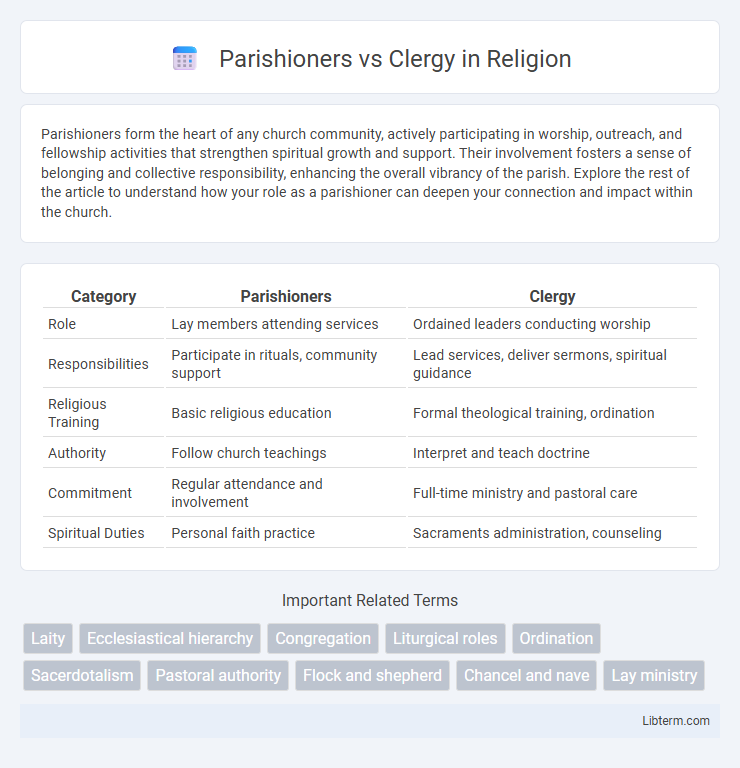Parishioners form the heart of any church community, actively participating in worship, outreach, and fellowship activities that strengthen spiritual growth and support. Their involvement fosters a sense of belonging and collective responsibility, enhancing the overall vibrancy of the parish. Explore the rest of the article to understand how your role as a parishioner can deepen your connection and impact within the church.
Table of Comparison
| Category | Parishioners | Clergy |
|---|---|---|
| Role | Lay members attending services | Ordained leaders conducting worship |
| Responsibilities | Participate in rituals, community support | Lead services, deliver sermons, spiritual guidance |
| Religious Training | Basic religious education | Formal theological training, ordination |
| Authority | Follow church teachings | Interpret and teach doctrine |
| Commitment | Regular attendance and involvement | Full-time ministry and pastoral care |
| Spiritual Duties | Personal faith practice | Sacraments administration, counseling |
Understanding the Roles: Parishioners vs Clergy
Parishioners engage in worship, community activities, and support the church's mission through active participation and attendance, embodying the laity's faith and commitment. Clergy serve as ordained spiritual leaders responsible for conducting religious services, preaching, administering sacraments, and providing pastoral care and guidance to the congregation. Understanding these roles highlights the complementary functions within church life, balancing lay involvement with clerical leadership to maintain religious practice and community cohesion.
Historical Perspective on Parishioners and Clergy
Historical records reveal that parishioners traditionally formed the foundational community of local churches, participating in worship and communal rites, while clergy held authoritative roles overseeing religious teachings and sacraments. The clerical hierarchy, often comprising priests, bishops, and other ordained officials, developed distinct privileges and responsibilities, differentiating them from lay parishioners. Over centuries, this division shaped the social and spiritual dynamics within Christian congregations, influencing church governance and lay participation.
Core Responsibilities of Clergy Members
Clergy members hold core responsibilities that include administering sacraments, leading worship services, and providing spiritual guidance to parishioners. They are tasked with pastoral care, counseling individuals and families in times of need, and fostering community cohesion within the congregation. Their role extends to teaching religious doctrines, managing church activities, and representing the faith community in broader social and interfaith contexts.
The Role of Parishioners in Church Life
Parishioners play a vital role in church life by actively participating in worship services, supporting church activities, and fostering community through volunteer work and outreach programs. They contribute to the spiritual growth of the congregation by engaging in prayer groups, religious education, and charitable missions. The collaborative relationship between parishioners and clergy ensures the vitality and sustainability of church ministries and parish initiatives.
Authority and Leadership in the Church
Parishioners receive guidance and spiritual support from the clergy, who hold formal authority and leadership roles within the church hierarchy. Clergy members, including priests, ministers, and bishops, are responsible for administering sacraments, interpreting doctrine, and leading worship services, establishing their position as spiritual leaders. The dynamic between clergy and parishioners centers on trust and obedience, as clergy provide direction and parishioners participate in communal faith practices.
Communication Between Parishioners and Clergy
Effective communication between parishioners and clergy fosters spiritual growth and community cohesion within religious organizations. Utilizing clear, empathetic dialogue and digital platforms such as church apps or social media enhances engagement and accessibility for diverse parish communities. Transparent communication channels support pastoral care, facilitate understanding of church teachings, and encourage active participation in worship and church activities.
Participation in Worship and Sacraments
Parishioners actively participate in worship through communal prayers, singing, and receiving sacraments such as Baptism, Eucharist, and Confirmation, signifying their personal faith journey and engagement with the church community. Clergy lead liturgical services, administer sacraments, and guide the spiritual growth of parishioners by interpreting doctrines and offering pastoral care. The dynamic between parishioners and clergy shapes the worship experience, as clergy provide sacramental authority while parishioners embody the living body of the church through their involvement.
Conflict and Resolution: Parishioners vs Clergy
Conflict between parishioners and clergy often arises due to differing expectations regarding church governance, doctrinal interpretations, and community involvement. Parishioners may seek greater transparency and participation in decision-making, while clergy emphasize hierarchical authority and spiritual guidance. Effective resolution requires open dialogue, mutual respect, and collaborative approaches to address concerns and reinforce shared faith values.
Evolving Dynamics in Modern Congregations
Parishioners and clergy in modern congregations are navigating evolving dynamics marked by increased collaboration and shared leadership roles. The traditional hierarchical structure is shifting towards more inclusive decision-making processes, reflecting broader cultural trends of democratization and community engagement. Digital communication tools and social media platforms further facilitate interaction and dialogue, fostering a participatory environment that redefines spiritual authority and communal responsibilities.
Strengthening Parishioner-Clergy Relationships
Strengthening parishioner-clergy relationships enhances community cohesion and spiritual growth within churches. Effective communication, mutual respect, and collaborative participation in church activities foster trust and deeper engagement between parishioners and clergy. Regular pastoral care, transparent leadership, and inclusive decision-making contribute to a supportive environment that empowers both clergy and congregation members.
Parishioners Infographic

 libterm.com
libterm.com